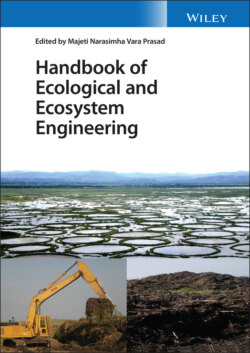Читать книгу Handbook of Ecological and Ecosystem Engineering - Группа авторов - Страница 42
3.4.3 River and Wetland Restoration
ОглавлениеRivers and other bodies of water (ponds, lakes, streams, waterfalls, etc.) are source of freshwater and support human and animal life on earth. A clean, self‐sustaining natural water system plays a vital role in ecological and socioeconomic development. With increasing population and thereby an increased pollution load on the environment, the sustainability of these natural services is of great concern. Thus, restoration of rivers and streams has attracted the attention of ecologists worldwide. This field is a booming enterprise and has received huge investments; it is reported that the US has spent billions of dollars on river restoration [30, 41].
Even though the importance of river restoration is understood, there is a gap between this consensus and the successful implementation of projects, which becomes evident from the rapid deterioration of freshwater sources. The restoration method selected must be based on several conditions regarding the particular river, such as geographic location, length/size, area covered, extent and nature of existing damage, stakeholder requirements, and the goal of the process. Palmer et al. [42] have proposed five standard criteria for monitoring the successfulness of ecological river restoration:
A dynamic ecological endpoint is identified in advance and used to guide the restoration.
Ecological conditions of the river are measurably enhanced.
The river ecosystem is more self‐sustaining than prior to restoration.
Implementing the restoration does not inflict irreparable harm.
Some level of both pre and post‐project assessment is conducted and information made available.
Questions may arise, such as what kinds of indicators to select that will be significant, repeatable, and reasonable for successful project evaluations. However, indicators may vary from the re‐establishment of a species to multispecies community restoration, depending on the predefined goals. There are two perspectives for selecting suitable indicators: one focuses on improving water quality as compared to the pre‐restoration state (i.e. moving away from the degraded state), while the other demonstrates how close the water quality is to that of a reference site (i.e. approaching the predetermined desired state) [42]. In this context, the chosen indicators must be easy to measure; be susceptible to changes in the system; display clear, predictable responses to such changes; and also be integrative. Jansson et al. [22] discussed the outcomes of implementation and practice of river restoration programs at the international and national levels to evaluate the understanding, accomplishments, and advancement of river restoration services.
Recently, a paradigm shift has occurred, such that river restoration design and construction imitate natural structures such as channelized streams without interfering with biomes,7 i.e. biomic restoration is greatly harnessed by biogeomorphic agents as nature's river restorers [64]. This approach is referred to as biomic river restoration. Biomic rivers are known to be resilient to adverse effects and are true examples of sustainable management or restoration solutions that reflect the future of river restoration projects. Figure 3.3 shows a section of Nippersink Creek (Illinois, US) being filled in to allow efficient farming by excavating a channel, contouring the banks, anchoring mats to control erosion, adding a mulching blanket and seeds to encourage native vegetation, and planting aquatic plants. The project is a perfect example of river restoration with multiple goals such as reduction of flooding downstream; improved water quality; habitat for fish, wading birds; and waterfowl; and involvement of youngsters in the process.
Wetlands are shallow‐water ecosystems that include marshes, bogs, vernal pools, and seagrass beds. These are also described as functions and services with broad ecological interest that serve as melting pots for public and private services promoting both consumptive and non‐consumptive assistance. Wetlands are considered a perfect example that integrates the approaches of two diverse fields – natural science and social science – thus enabling the economic validation of policy development and research [56]. For economic validation, however, ecosystems are subdivided into small sets that can deliver functions and services since it may not be possible to include the entire ecosystem during validation with standard methods.
Wetland restoration focuses on the construction of water conservation and protection of riverine wetlands, as they provide shelter to aquatic animals and plants. Water quality improvement, biodiversity maintenance, flood abatement, and socioeconomic uplift are among the additions to the ecosystem [6]. Another important future aspect of wetland restoration is its contribution to controlling global climate change. About 6% of the world's land is covered by wetlands, while approximately 12% of the global carbon pool is known to exist in these wetlands; thus they play a vital role in the global carbon cycle [15]. Climate change must also be addressed during the implementation and practice of restoration projects, with future ecosystem management policies as an inevitable domain of climate change and mitigation processes.
Figure 3.3 A 2.6 km section of Nippersink Creek (Illinois, US) is filled in to make farming more efficient.
Source: Reproduced with permission from Zedler, Joy B. (2000). “Progress in wetland restoration ecology.” Trends in Ecology & Evolution 15: 402–407. ©2000, Elsevier.
On the other hand, there has been a decline in several ecosystem services resulting in severe alteration or complete disappearance of wetlands in recent years. For instance, alteration of habitat by a multistage dam constructed on the Min River in China led to a rapid decrease in the population of S. Prenanti8 [46]. A very common example is floodplains, which can include one or more types of wetlands, primarily including submerged grasslands, wet meadows, forests, woodlands, and shrublands. Degradation of these ecosystems can be correlated with the deterioration of freshwater biodiversity due to habitat alteration, species migration, pollution, and flood‐control mechanisms. The disappearance of natural floodplains and rapid extinction of aquatic and riparian species pose a worldwide threat to the biodiversity of these systems. Perseverance of existing floodplains and restoration of hydrological ecosystems, riparian vegetation, and sediment transportation require urgent attention to retain ecological integrity and sustainability.
